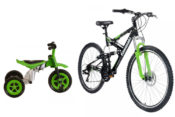INTERVIEW
Gary Sutherlin | 2017 WORCS & AMA Hare & Hound National Champion
Most racers go into the racing season with their eyes focused on winning a championship, not two championships, but Gary Sutherlin isn’t most racers.
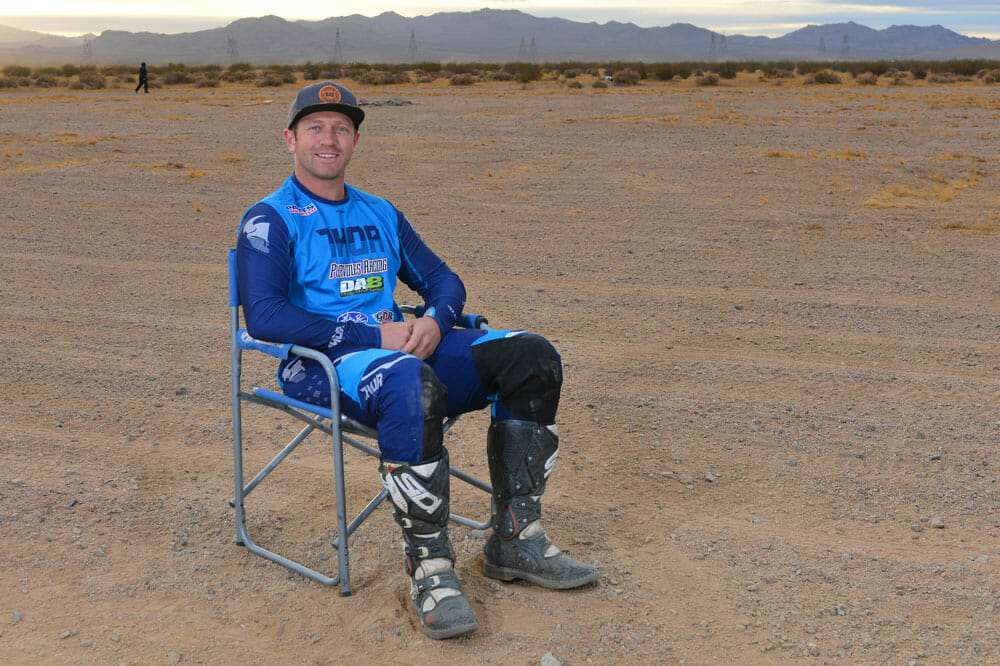
Gary Sutherlin doesn’t mind doing things the hard way. Wrenching on his race bikes, driving to the races in his own truck, and doing pretty much everything on his own—including raising his now six-year-old daughter Emerie—doesn’t faze the 30-year-old from Arizona. Instead, the “blue collar” racer simply goes about his business, doesn’t complain, and gets the job done, the job of winning championships, that is.
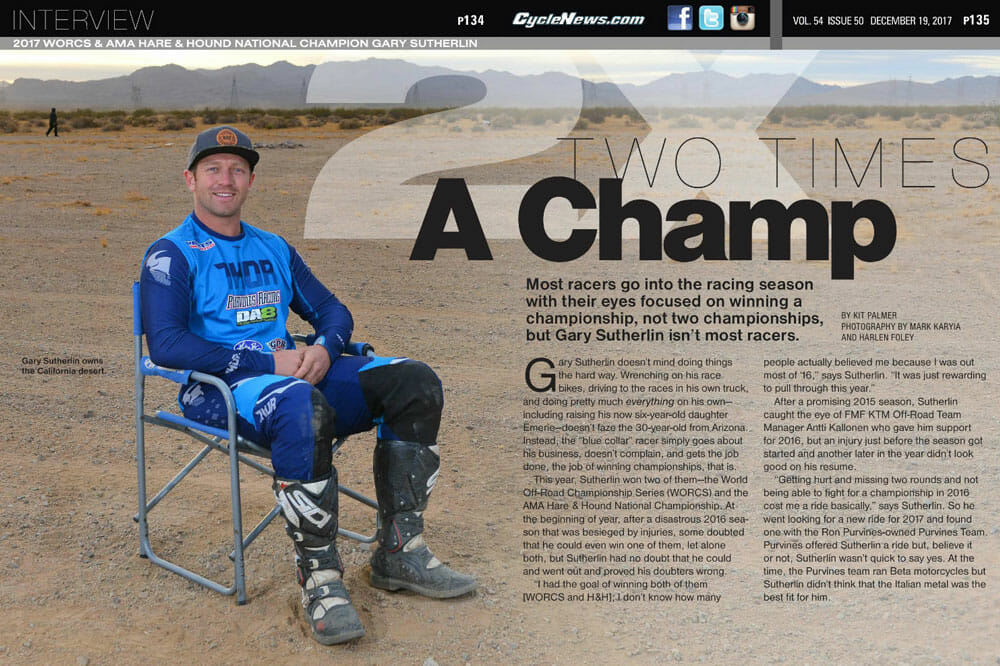
Click here to read this in the Cycle News Digital Edition Magazine.
PHOTOGRAPHY BY MARK KARYIA AND HARLEN FOLEY
This year, Sutherlin won two of them—the World Off-Road Championship Series (WORCS) and the AMA Hare & Hound National Championship. At the beginning of year, after a disastrous 2016 season that was besieged by injuries, some doubted that he could even win one of them, let alone both, but Sutherlin had no doubt that he could and went out and proved his doubters wrong.
“I had the goal of winning both of them [WORCS and H&H]; I don’t know how many people actually believed me because I was out most of ‘16,” says Sutherlin. “It was just rewarding to pull through this year.”
After a promising 2015 season, Sutherlin caught the eye of FMF KTM Off-Road Team Manager Antti Kallonen who gave him support for 2016, but an injury just before the season got started and another later in the year didn’t look good on his resume.
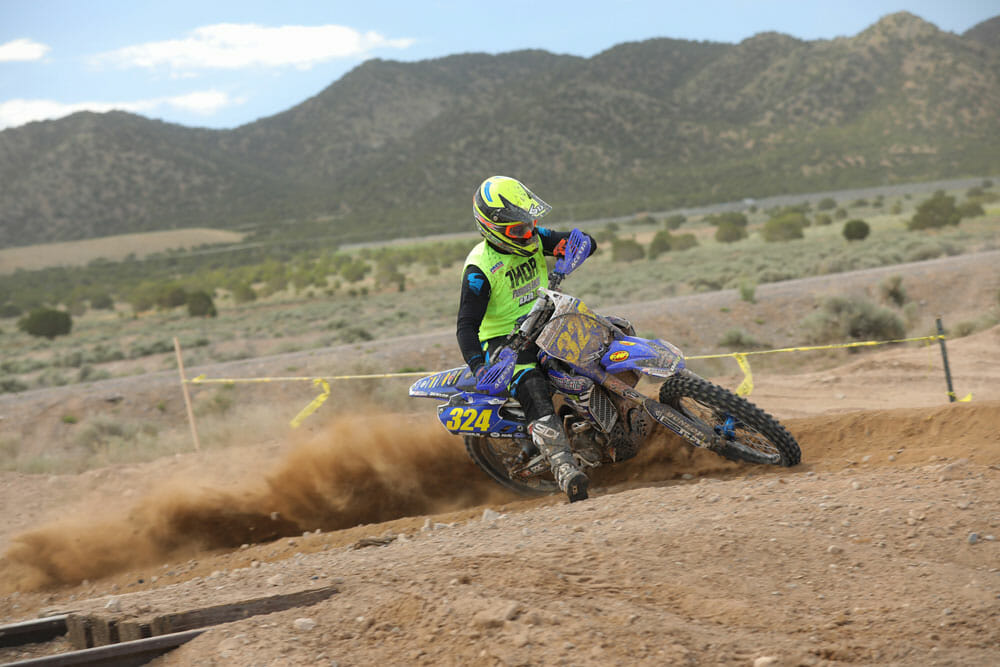
“Getting hurt and missing two rounds and not being able to fight for a championship in 2016 cost me a ride basically,” says Sutherlin. So he went looking for a new ride for 2017 and found one with the Ron Purvines-owned Purvines Team. Purvines offered Sutherlin a ride but, believe it or not, Sutherlin wasn’t quick to say yes. At the time, the Purvines team ran Beta motorcycles but Sutherlin didn’t think that the Italian metal was the best fit for him.
“Ron called me and said what’s it going to take for you to ride for me next year? I said, ‘No offense, Ron, but until you’re off of Betas…’” is when he would seriously consider riding on the Purvines team. “It’s nothing against Beta, it’s just I know how hard I am on motorcycles; for East Coast stuff and even West Coast stuff, for the right guy, I feel like it’s a decent bike, but it’s just not something I feel like I could win on. He was like, ‘well, what would you like to ride?’ I said, ‘Yamaha.’”
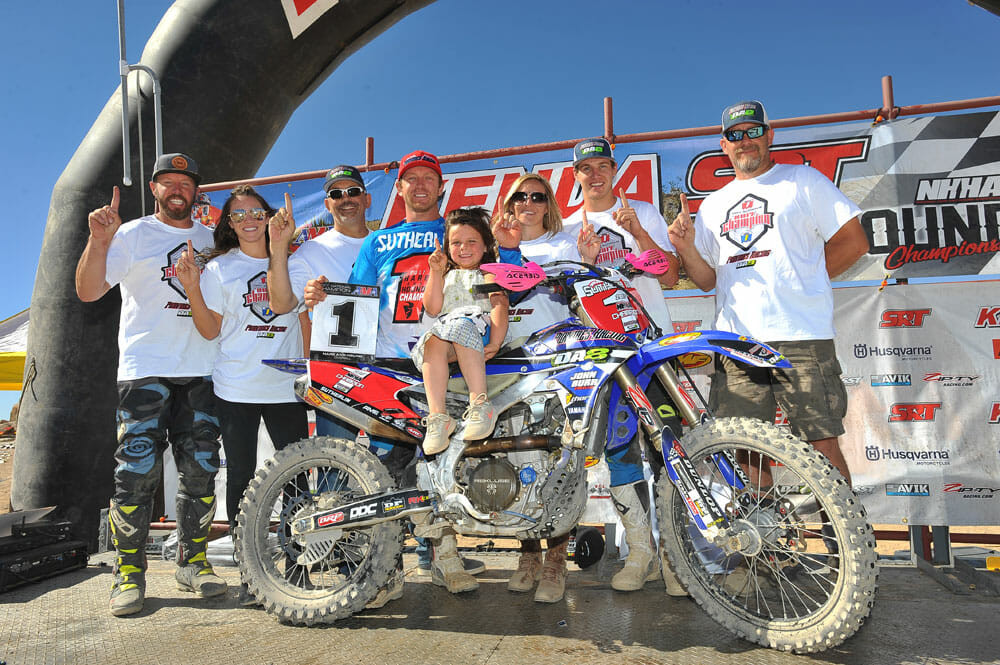
Purvines eventually made the switch to Yamaha and partnered with Destry Abbott to form the Purvines/DA8 Yamaha off-road team. Now, things were looking bright for Sutherlin who liked the idea of riding Yamahas, which have a reputation for being well built and reliable in the dirt, which are things Sutherlin, who is known to be hard on his equipment, felt he needed to win a championship.
“I’m not a finesse guy. I’ve never been,” says Sutherlin, “but I’ve been getting better at it. It’s kind of funny because Destry has been a big influence on my off-road riding and all that stuff for many years. He’s always laughing and making fun of me. ‘Dude, you got to shift!’ Destry would say. I was a revver, kind of like a Barcia, just rev, rev, rev. I’ve really gotten away from that, but I still have that aggressive style, aggressive mentality, but I’ve worked really hard on smoothing out. Going to Six Days, riding with Taylor [Robert], watching videos of Taylor riding and stuff—he’s very smooth and precise and upshifts and is up a gear high in stuff. So, it’s just over the years I’ve been trying to adapt to smooth myself out a little bit.
“Everybody has their own ways. Is going super smooth and upshifting always the right way? Maybe for that person, but for me, I might hammer it really hard. But that comes back to keeping the bikes together. I used to be really hard on bikes as far as breaking stuff during races. So, one of my mentality things was you can’t win the race if you break. So, I had to change my riding style up a lot and try and salvage the bike for these long races.
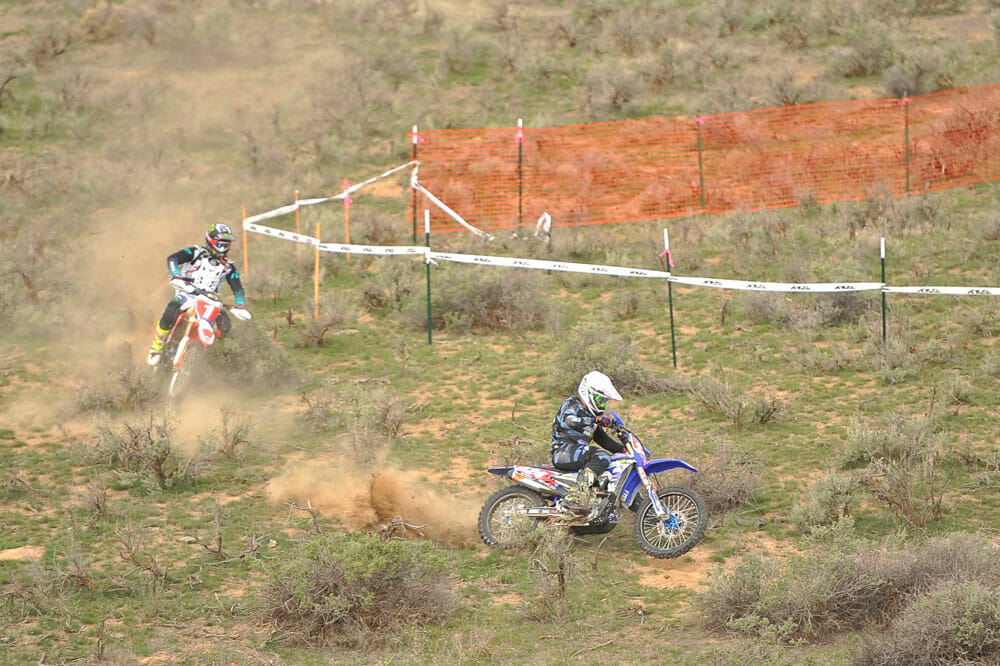
“That was a huge thing [switching to Yamaha]. That’s what Ron was asking: ‘Why Yamaha?’ First off, the bikes are bulletproof. This year I raced bone-stock Yamahas all year. I never touched the motor once. I never put a piston in it; as far as trying to make them faster, trying to change cams, I didn’t mess with it. Every championship I won was on an exact bike you could go buy.”
Sutherlin had choices, too: YZ, WR or FX 450cc Yamahas.
“I started the year out all on FXs, and then Havasu we had a fuel pump/wiring harness issue. So, I ended up borrowing Destry’s YZ and I was like, ‘Oh man.’ The tranny was way better for moto scenarios, so I ended up switching about halfway through the season and running YZs the rest of the season at WORCS, and then I ran an FX in the desert.
“The big thing is the transmission. First and second gears on the FX are really tight, and there’s a huge gap from second to third. So, in the desert it actually works pretty well, because I’m in second gear in the rocks a lot. But for moto, second is so tight and there’s such a gap to third; when you go from second to third there’s a bog in there. It just won’t carry the rpm. So, that’s when I chose to ride the YZ.”

Even though WORCS and hare & hounds are two very different types of riding, Sutherlin says his bikes are set up fairly similar.
“Ty Davis has been doing my suspension all year. It’s been really good because I’m known for somebody who’s picky about suspension. So, what’s good about Ty is, he’s a guy that is still a phenomenal rider. He still rips. So, we go out to test and I say, ‘Hey, Ty, this is what’s going on.’ He’ll make a change and I’ll go, ‘man, it’s still doing it.’ He goes, ‘How is that possible? I changed these shims.’ So, he’ll jump on the bike and go, ‘Oh, wow, it’s still doing exactly what it was.’ So, that’s what’s good with Ty as far as communicating—working with somebody and them being able to feel what you’re feeling is huge.
“But as far as overall setup goes, I ran a pretty much WORCS/moto setup for most, even the hare & hounds. My bikes were pretty similar, which is kind of crazy. I actually ran the first WORCS race on the FX. IMS makes a 2.5 [gallon] tank for the FX, and a 2.9 tank for the YZ. I’d say that was the biggest changes. We got lucky the first WORCS race. They pitted me at 50 minutes, and luckily they did because I wouldn’t have made it off the motocross track
“So, I had to pit twice because the 2.5 was too small. So what I did was I take a YZ [IMS] tank and stripped all the stuff off the fender on the FX, and then we ran an anti-gravity battery, the real thin one, the light one. I cut a hole in the bottom of the seat and actually put the battery in the seat, and then put all the wire harness stuff behind that, up above, so I could run a 2.9 tank. I did all that myself. I was my own mechanic this year. I did everything.”
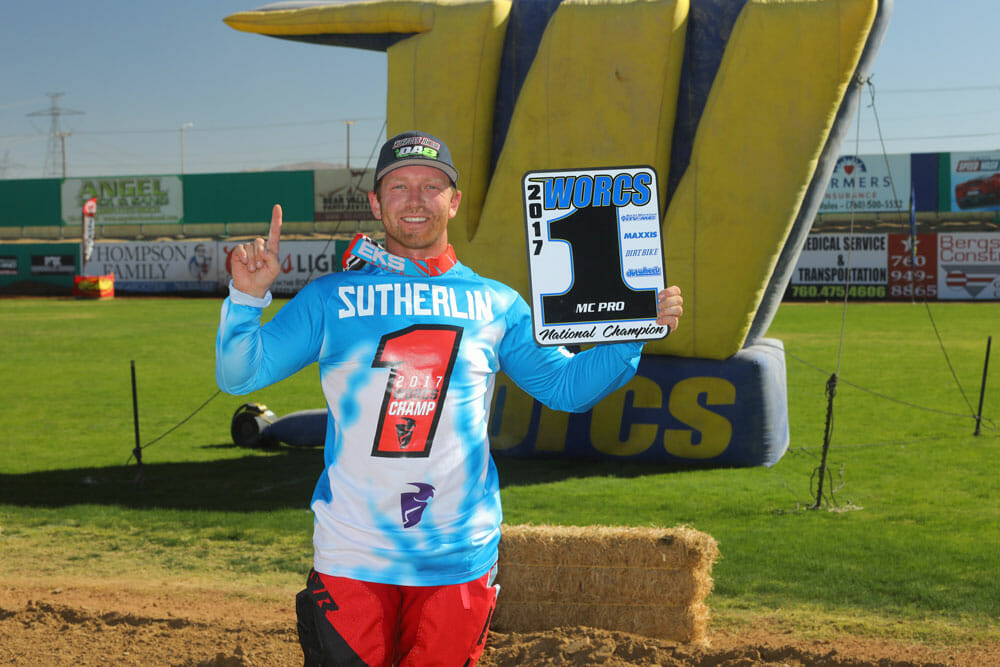
Being his own mechanic is nothing new to Sutherlin. He grew up in Montana where he rode mostly motocross then moved to Arizona to attend the Motorcycle Mechanics Institute (MMI). In Arizona, he met Destry Abbott and they became good friends and later became Ricky Dietrich’s tuner for a while. After hanging out with these guys, it wasn’t long before Sutherlin’s interest turned from MX to off-road.
“Purvines Racing is based out of Vegas. Collin [Woolsey] is the team manager/mechanic, but for me they weren’t going to all of the WORCS races, just the hare & hounds. We talked about getting me a mechanic but it was just unfeasible. So, with my mechanical background I was like, I trust myself. It was a lot of work. It was way too much work, actually. I did everything from race preps to practice-bike stuff to solving little issues. And then luckily I had some really good buddies that came with me to the WORCS races that helped pit.”
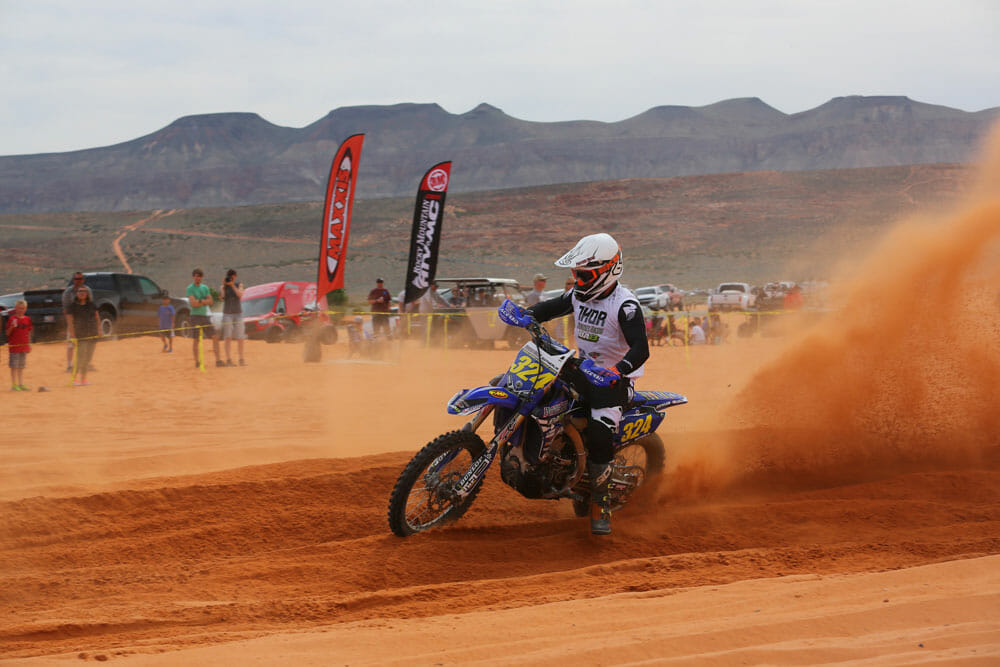
As mentioned, Sutherlin grew up in Montana. “I was born and raised there. I started racing there. I did one outdoor national [MX] in ‘05 but I broke my arm and I kind of needed to make money. I didn’t have rich parents or anything, so I decided to go to MMI. I went down by myself when I was 18 and lived in Phoenix for about six years. I actually worked at a motocross track running heavy equipment, and then I started working for Jonny Weisman, who is Destry’s mechanic, and that’s how I started getting into off-road.
I was like, ‘Oh my gosh! Destry Abbott wants me to go ride with him.’ It was so crazy because now me and Destry are pretty much best friends. Back then I always idolized and looked up to the guy. Then I wrenched for Dietrich the end of 2006 when he won his championship. It’s kind of crazy that I won a championship with Ricky as a mechanic and then I also won one as a racer.”
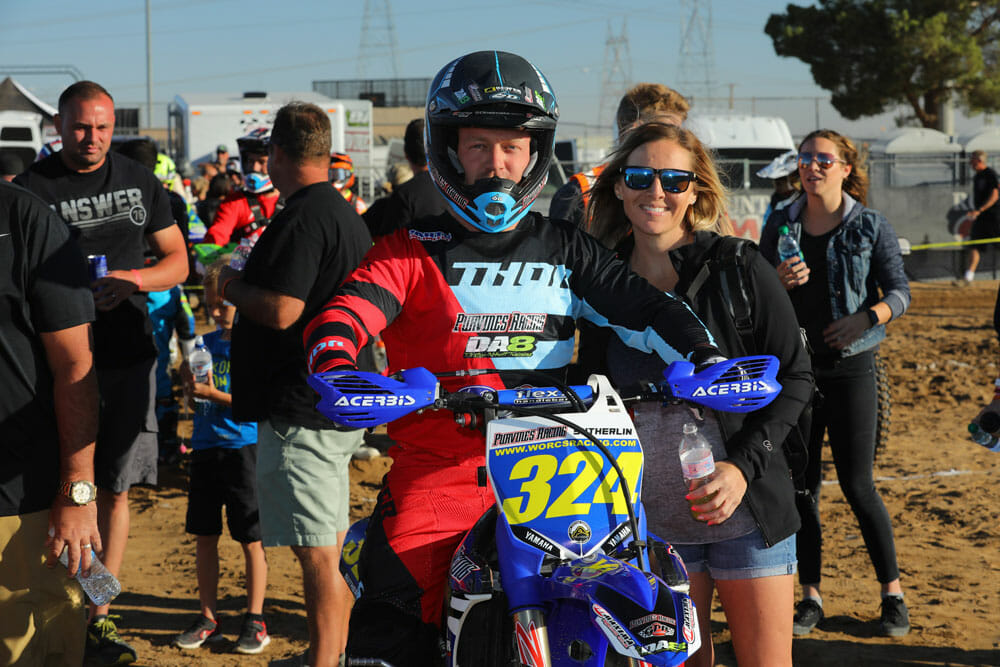
Sutherlin admits that he’s not crazy about being his own mechanic.
“Not anymore. I would like applicants please for a mechanic! Being a single dad, working on bikes, trying to train and practice and do everything—I spend a lot of time in the shop—it gets overwhelming. But that’s with anything. I’m thankful to have what I have and be able to do what I’m doing, but at the same time it’s like, man… it’s a lot.”
Every minute of every day is pretty spoken for when it comes to Sutherlin’s everyday life.
“Emerie, my daughter, she’s six now. She’s in first grade. She goes to school at 8:40 a.m. and I pick her up at 3:30 p.m. So, basically I get up, make us breakfast, do everything and get her ready for school. I basically have to say from 8:40 to 3:30, that’s my time to do what I need to do to race. That’s when I have to fit in bicycle rides, track and as much bike work as I possibly can in that small amount of time. Then after that there are nights where you have to spend down at the shop.
“Luckily, I have a house now with a shop and I put a TV in it and stuff. She rides around on her scooter. It’s getting easier. Basically it’s about getting it all done between 8:40 and 3:30, because at that point it’s more about getting her schoolwork done and making sure she’s on top of what she’s got going. Then it’s cook dinner, do laundry, do dishes, do all the home stuff that I got to do, too.”
And things certainly don’t slow down on race weekends. “I wait until she gets out of school on Fridays. I try not to make her miss any days. I think she only missed two days last year. That’s the big thing is keeping her in school and keeping her focused and doing what she’s doing. Then, at the races, I find people, friends and buddies, and people’s wives to help out. I’ve been very lucky to have people help me out. Now I have a girlfriend and she’s been able to help and step up at the races and watch Emerie. That’s taken a little bit of stress off, so that’s been good.”
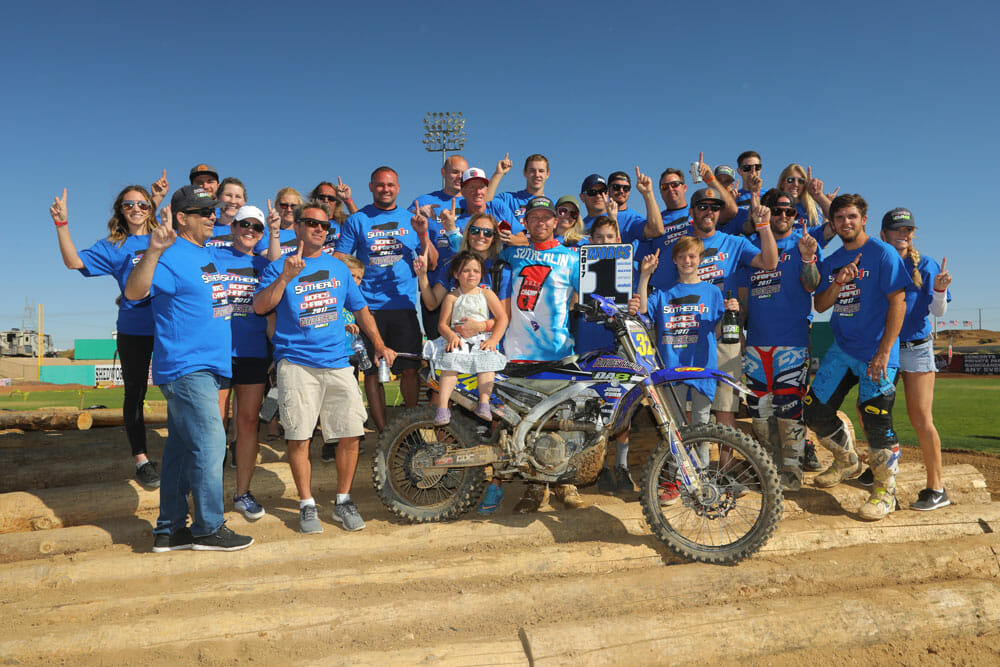
Sutherlin said that his WORCS championship wasn’t handed to him by any means.
“I gave everybody else more than a perfect chance to win it,” he says. “I had a lot of little issues this year. I came out and I was being consistent. Taylor got hurt unfortunately, but I was able to capitalize on that and won a couple races. Then I had a pretty good injury in the middle of the season at one of the WORCS races, which I basically DNF’d and lost points.
“Then I had a bike issue at Glen Helen and got last in that. We got points, but it was kind of a mess; it kind of got a little messy there three-quarters of the way through the season, but it all came together. That’s part of it; you have to keep it together. That’s what a championship is. It’s not just one race, it’s putting it all together.
“Taylor basically came back on the WORCS side and I had a big enough points gap,” says Sutherlin of Taylor Robert who won every WORCS race that he rode. “I didn’t really have to race him, so realistically—I don’t want to sound like I Dungey’d it—but I did. I just rode and tried to beat him but I wasn’t going to push it and ruin my chances of winning the championship.”

Sutherlin says the transition from WORCS to H&H isn’t exactly easy.
“It’s not. The hare & hounds, it’s getting your eyes to adjust, being comfortable letting the bike move around underneath you. You’re hitting stuff at such a high rate of speed and it’s unknown, and that’s the scary part. It’s a lot with my eyes. I like to go out and ride fast stuff the week before for at least two days and really get my eyes adjusted. You don’t really notice it until you take time away from riding desert.
“I don’t really ride a whole lot of desert necessarily. I like to go trail ride and stuff like that, but it’s a lot of just letting your eyes catch up with what’s going on.
“With WORCS you’re thinking about lines and hitting your line and next lap hit this, hit that, where hare & hound you’re visually looking at something and forgetting it as soon as you hit it. You’re looking for a rhythm. Where’s the next rock? You’re always looking. Where’s the ditch? I hope I don’t hit that road crossing too fast. You’re on your toes. There’re always a lot more close calls at hare & hound racing, for sure.
“It’s super scary because, as good a job as everybody does marking the course, those guys don’t know the speeds we’re actually hitting or coming up on stuff, so sometimes stuff is marked late. Luckily with the help of the Kurt Caselli Foundation now, they’re working really hard at trying to make hare & hounds safer. I’m a huge advocate for making it safer. I’ll be honest with you; I’m basically scared shitless racing hare & hounds most of the time. I never get half as nervous at a WORCS race as I do at a hare & hound. That’s just the speeds.”
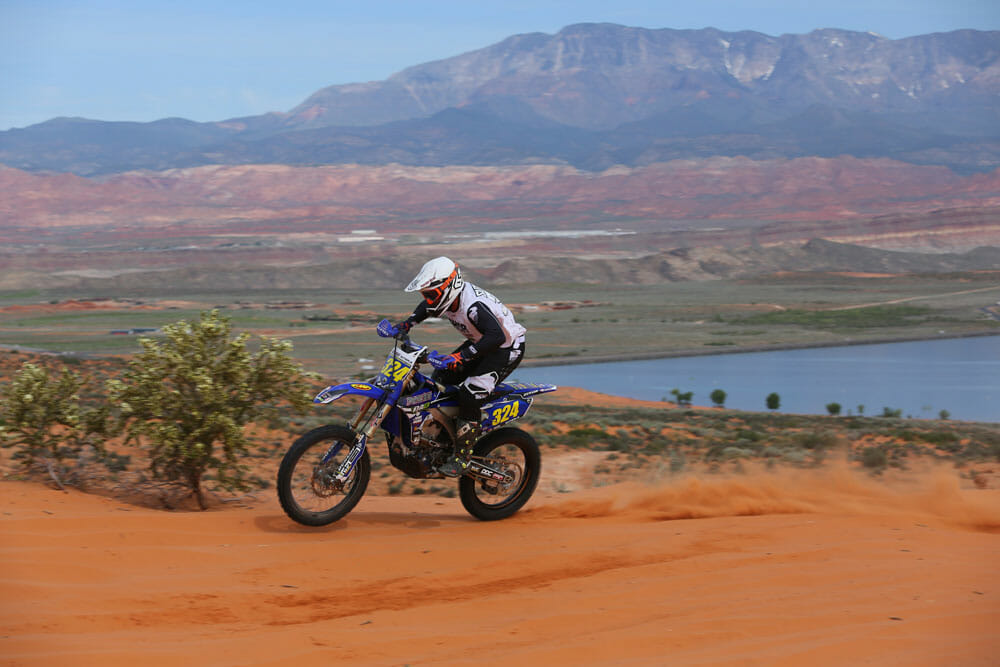
Sutherlin says he plans to defend both titles next year.
“Yeah, that’s the plan right now. I’m not 100% sure. I might add Big 6 in. We’ll kind of see and just wait. I know the team’s waiting in limbo. We’re talking with Yamaha, trying to get the whole program set. Then that kind of determines what I’m going to ride and how much is available to me as far as parts and all that stuff, and where they want me to focus.”
Sutherlin loves racing but says there is a lot more to it than meets the eye, mainly the pressure to do well. “People are like, ‘Oh, man, that’s so awesome. You get to do it [race dirt bikes for a living].’ I’m so appreciative and so thankful that I’m able to make a living and make decent money to go racing and take my daughter with me. But what they don’t understand is when it’s hot out and you’re going to the lake and partying, I’m having to do motos, having to eat salads and crap.
“Then come Sunday, you can’t have a bad race. The competition is too stiff. You can’t have a bad race. You have to be there every single weekend. There’s a lot of pressure. That taxes you mentally, too. It’s a lot more than people think it is. A lot of people, when it’s a hobby it’s like, ‘Oh, man, this is so awesome.’ You know that time when you shut off going across the desert because you don’t want to get hurt? Well, I have to keep it on! You have to risk it a little more.
“When you start winning quite a bit, even the excitement of you winning goes down because it’s so expected of you. So I would say the pressure gets almost more as you start being more successful, because not only are your expectations higher, but so are everybody else’s. So, it’s a cut-throat business to be in.”
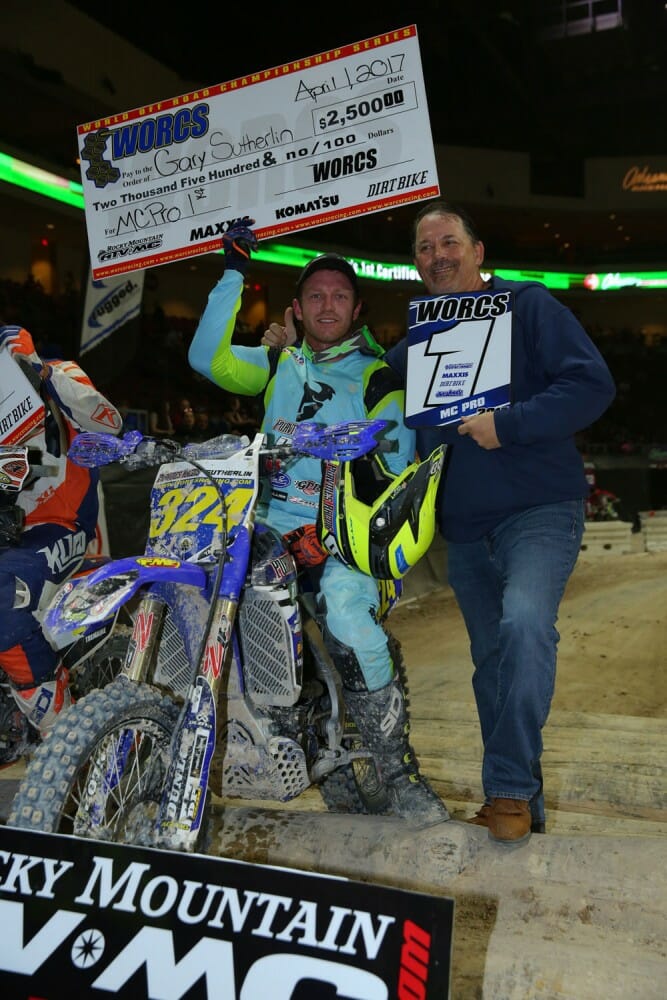
So how does he deal with it all?
“The way I deal with it, the pressure, I can control one thing: I can control winning the race or not. All the other stuff, the buzz, the social media, all that stuff, I can’t control what Cycle News writes, I can’t control what Dirt Rider [writes], what anybody posts, so the pressure is on me and my goals now.
“I’ve realized as I’ve gotten older that it doesn’t matter who writes what. It’s about what I want to accomplish and the goals that I set to succeed, and show my daughter how hard work pays off and all that stuff. That’s kind of how I’ve dealt with it. I’ve kind of just twisted it a little bit like, ‘Hey, this is what I expect.’ If I meet my expectations, everybody else can be happy, too.” CN
Click here to read this in the Cycle News Digital Edition Magazine.
Click here for all the latest motorcycle Industry News on Cycle News.
